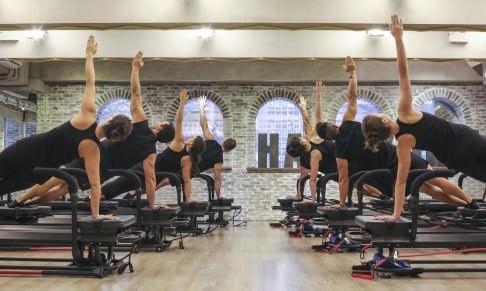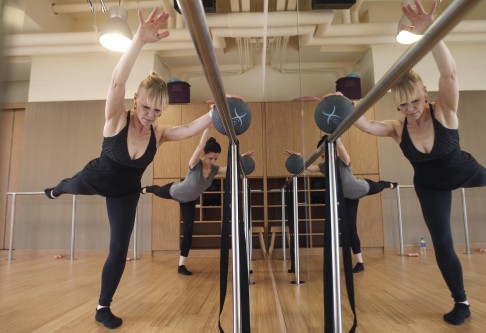
Fusion fitness classes are all the rage, but are they are good as is claimed?
Fusion fitness classes offer a multitude of combinations of different disciplines, but not everybody is convinced, writes Rachel Jacqueline
When it comes to working out, why shouldn't you have it all? So goes the mantra for the latest fitness trend known as fusion fitness - workouts that combine cardio and strength with balance and offer hard-core, time-poor fitness fanatics a way to get it all during their lunch break.
There is "Piloxing" (Pilates and boxing), "Pound" (drumming, Pilates and isometrics), "Tread" (treadmill running and weight lifting), "YAS" (yoga and cycling) and, of course, Taebo, one of the original fusion workouts, a combination of Thai boxing and cardio. Originating in the US, these workouts are intense but deliver results, or so it is claimed.
By the end, you just want to cry. Your body is shaking and you're dripping in sweat
In Hong Kong, boutique studios promising full-body workouts have sprung up around the city and even big box fitness gym Pure Fitness has expanded its group class workout schedule to include fusion-style classes such as "Cardio Pilates", "Dance Fitness" and "Yoga-lates".
So what's all the fuss about? Combo workouts are fun. And while you're pumping, grinding and bopping along you forget you're working up a sweat.
"It feels like it's a party," says 27-year-old Edward Mueller of the spinning experience at XYZ. The city's latest cycle studio offers community fitness in a club-like atmosphere where cyclists spin to heavy beats while pumping light weights.
"It's about creating entertainment in fitness. At the end of the day, working out has to be something that people actually want to do," says Rachel Moon, an XYZ instructor.

"Getting to classes felt ike a chore. With XYZ, I love the atmosphere and the energy. The playlists are constantly updated with upbeat music so that you don't fall into a boring routine."
Fun is also the aim in the range of dance-fitness classes now available in the city. At Aerial Arts Academy, students use poles, chairs and hoops with burlesque moves.
"Our classes are designed to fuse fitness training with a variety of sensual and saucy dance moves, gradually building up confidence, stamina, balance and stability," says co-founder Becky Chan.
Putting a modern twist on traditional disciplines enables you to hit your full potential.
"It's about mixing it up a bit. One needs to cross train to be really fit these days," says former professional ballerina and Pilates instructor, Anna Serafinas Luk, who is now an instructor at Flex.

"It has a good balance of cardio and sculpting moves targeting muscle groups you didn't know you had," says 32-year-old Xtend Barre fan Luisa Cooper, who followed the trend from New York to Hong Kong.
"The workout is particularly good for women's bodies - it's ballet-based, not burpees, weights and blokes. It's nice to sweat with a little finesse."
The aim of these blends is to create an impact felt directly on the waistline, says Vivienne Fitzpatrick, co-creator of the H-Kore studio in Central which offers the Lagree fusion-style workout.
"After just a month I lost an entire dress size," she says. "By the end, you just want to cry. Your body is shaking and you're dripping in sweat."
Created by Pilates instructor Sebastien Lagree 13 years ago, the Lagree workout mixes Pilates, strength and cardio with science - all workouts are performed on Legree's space-age Megaformer.
But there is a catch. Fusion workouts are not cheap, with some costing up to HK$350 a class. Unlike a gym membership, most boutique fitness studios work on the pay-as-you-go model. Work out the recommended four times a week and you may end up spending four times the amount of a monthly gym membership.
It's worth it, says Fitzpatrick, and it's cheaper than a personal trainer. "It's bad to be motivated by guilt - pay when you want to workout. There's a realisation that if you want to have a stronger, leaner and healthier body, you have to invest in that."
But for purists, some of these blended workouts water down basic principles and techniques. The original full-body spin workout from the United States, SoulCycle, has been criticised for causing lower back pain in riders whose feet are locked into pedals while their upper body moves around.
"High intensity cardio and strength training are a great combination of training both aerobic and anaerobic systems, but the issue is when complicated strength or speed movements are poorly programmed or supervised. The risk of injury increases significantly," says personal trainer Alex de Fina.
But do these fusion fitness programmes actually work?
You might think incorporating cardio into slower tempo and technical strength disciplines would burn more calories and activate otherwise inactive parts of the body (like the upper body in cycling) to create a full-body workout. But it's not so straightforward, says de Fina.
"There's a misconception about burning calories. To achieve a change in your body composition and to lose weight you have to do something differently than you're used to doing," he says. "Nothing is new in fitness; cross training has been around for eons.
"An ideal workout is one where it hurts; anything which mixes things up dramatically will induce stress and, therefore, hopefully, a range of physiological adaptations," he says, which is a philosophy he admits goes against the idea behind fusion workouts. But he doesn't discount the importance of enjoying oneself.
"A sense of camaraderie is going to keep people coming back."
Besides, not all fusion workouts are created equally. Lagree fitness, offered by H-Kore for example, offers scientific research and reviews on its website. Pound was devised by two 20-something fitness junkies who liked to drum, and Piloxing was created by Viveca Jensen, a ballerina who liked to box.
"It's important to check that your teachers are fully qualified for any group fitness workout. All our Xtend Barre teachers have their full Pilates qualification," says Luk.
Despite the hype, fusion fitness classes remain only a small part of the schedule at Pure Fitness, says Brad Wharakura, group fitness manager.
"They're a nice addition to draw people into different disciplines, but we tend to stick to the stuff which is tried and true, like RPM, cycle, body pump and body combat, and TRX."
Wharakura says the success of group fitness boils down to results and motivation. "If people see results they'll come back; the motivation part is incredibly instructor driven. I think what people really enjoy is the novelty of it, but you get the same training and results. I think it's the way it's packaged, really."
